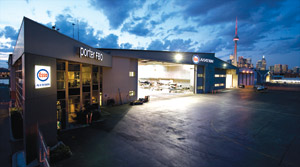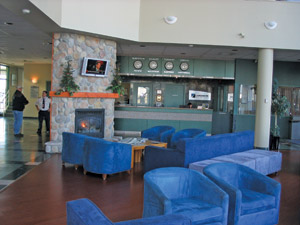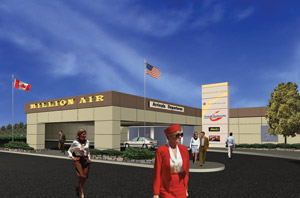
Features
Operations
Canada’s FBOs: Ramping up despite rising costs
The price of gas is something that we all are keenly aware of today. Television starts and ends the day with a “price at the pumps” report and a quick view of the world cost of oil per barrel.
October 8, 2008 By Rob Seaman

Porter Airlines operates an Esso-branded FBO that has seen a complete and total refurbishment in the last year modelled after Porter Airlines’ renowned passenger lounge.
|
The price of gas is something that we all are keenly aware of today. Television starts and ends the day with a “price at the pumps” report and a quick view of the world cost of oil per barrel. To the average person, there seems to be no limit to the increases – and for those trying to run a business that depends on this commodity, it is damn near impossible to budget or plan properly. Oil is the differentiator in business today and has a broad-reaching affect on our home and personal lives. And as we have seen so many times before, when things get tough in the world, what happens at the pumps eventually triggers life changes in other ways – especially in the aviation sector.
The airlines and GA operators combined make up the volume that many FBOs rely upon. In case you had not heard, they are not doing so well. Those large uplift, into plane contracts from the airlines and courier/cargo fleets only pay if the volume is there. So when Air Canada announces cutting routes and jobs, and then Jazz does likewise, the smaller regional airports where FBOs play such an important role in service and support to all aircraft traffic at their locale, suffer.
Likewise, as we hear of folks driving less, the discretionary funds taken from the average family budget for recreational flying is also beginning to suffer. Hangar doors remain closed at some flying clubs and tie-downs full at other airfields. Pilots cringe and hold out for lower prices at the pumps. The resale numbers of GA-type aircraft currently advertised for sale are growing – especially with regard to the older airframes. According to some brokers at the recent CBAA convention, the market of today is “buyer” rather than “seller” focused. Prices are falling and inventories of higher time, “legacy”-type aircraft, are swelling. A year or so ago, you might have found the aircraft of your desire here today and gone tomorrow, but buyers now are taking their time. Chances are it will still be around when they come back. If not – well, there will be another. All of this combined affects the world of the FBO operator both for good and bad.

Last year Landmark Aviation YVR added another 80,000 sq. ft. of hangar/building and extensive ramp space to its existing 110,000 sq. ft. and also spruced up its main passenger lounge area – giving it a local B.C. flavour.
|
The price for fuel used to change monthly at most FBOs. That is a distant memory now. Not quite as bad as the auto retail sector yet, which changes daily or more often, most FBOs in North America are now subject to weekly price corrections. In Europe however, it’s almost daily. And the cost of a barrel or litre is leading to careful, creative “shopping” for a few cents break here and there. The common water-cooler chat – When is this going to stop? And that old favourite that used to be solely the focus of the international corporate traveller – “tankering” fuel – is more prevalent now at all levels than ever before.
Have heart – not all the news is grim! Gordon Berturelli is the senior VP, International Business Development with World Fuel Services (WFS) based in Calgary. The WFS group of companies includes Baseops and AvCard. In looking at the Canadian FBO market, he comments that apart from the rising cost of fuel on a daily basis, they feel that nothing has changed too much within the Canadian marketplace. If anything, he reports an overall increase in traffic and volume, even with the current environment that the global market is experiencing. As Berturelli sees it, corporate flight departments are paying more and more attention to fuel prices, in particular with regard to international travel. “The pilots are continuing to consult with us to ascertain if there is a better way to buy their fuel,” he says. “As a fuel management company this is something that I think all corporate flight departments should be looking at. I know that sometimes flight departments either do not have the luxury of time nor the staff resources to help them in this cause, but we can. We have a dedicated sales and support staff to relieve that burden should the customer require some additional help.”
Groups like WSF work closely with the FBOs, and that in turn relates to mutually beneficial business development and client retention – something that is even more important during pricing and economic challenges. To that extent, Berturelli reports that some of the initiatives that WSF has undertaken recently include working with the FBOs to direct and build business. As an example, in Canada, continental North America and places enroute that may see a volume in traffic due to the China Olympics, WSF has worked with the key enroute locations to ensure that all is as it should be and that their Canadian clients get a continuity of service and support from their home base outbound and back.
Basically, corporate aviation is still running more or less in top gear and showing few signs of slowing down. Aircraft orders are still up, resales continue strong and charter activity, while a little slack for some in the early months of this year, is getting surprisingly robust again, according to many reports. So the larger, corporate-focused FBOs at the international airports remain busy and relatively happy. Ramps seem active and hangars are definitely full to overflowing. That is good news in the overall scheme of things. It is the more numerous and vulnerable regional/catch-all FBOs that are seeing signs of slowing.
Continuing on the good news, some established FBOs are even moving now to continue their growth and expansion plans for the corporate clientele. A key example is Million Air Toronto, located at Toronto Buttonville Municipal Airport (YKZ). During a reception at the recent CBAA convention in Toronto jointly sponsored by Million Air Toronto, Air BP and Million Air, Derek Sifton, president and second generation of his family to be in charge of this airport, announced that Million Air Toronto will be growing and redeveloping itself to become a proper home and support site for business aviation in the Greater Toronto Area. Over the coming months they will be revamping their site with a new multilevel Million Air lounge and corporate centre. As Sifton observed in his introduction, “not all the air routes in Toronto go to YYZ and the rumours of our closing or sale are just that – rumours. We have been here for a long time looking after our clients and plan on sticking around for a few years yet. With the growth and evolution of corporate aviation in the GTA, and the increasing demand for less crowded and easier access alternatives to the International, we felt it was finally the right time to redo ourselves and create something that exceeds the physical standard of FBOs today. Our level of service, the direct access we provide to the downtown core and our less congested traffic pattern have always been added bonuses to coming here. We also have lower landing fees and with the rising price of fuel, the pressure to save where you can is making folks look for alternatives. With a shiny new face and improved amenities, we offer corporate travelers a genuine and honest alternative.”

Over the coming months, Million Air Toronto located at the Buttonville Municipal Airport will be revamping its site with a new multilevel Million Air lounge and corporate centre.
|
Based at the Toronto City Centre Airport (YTZ), Porter Airlines continues to be a success story and its focus is by no means limited to commercial operations. It operates an Esso-branded FBO that has seen a complete refurbishment in the last year. The recently completed renovation features a new modern design and a spacious environment that is modeled after Porter Airlines’ renowned passenger lounge. The renovation also expanded the pilot lounge and corporate passenger waiting area and includes an upgraded modern weather centre. Brad Cicero, Porter’s manager of communications and public affairs, says that in the last nine months Porter FBO has seen its fuel sales increase by 29 per cent. Along with that there has been a significant rise in tenancy and itinerant traffic. In addition to the FBO revamp, last year Porter FBO opened a new state-of-the art fuel farm to help meet demand. Once again this shows that location and quality attract business. Porter invested for the future at the right time, it would seem.
Skyservice continues to improve and evolve its FBO offerings too. Lyn Shinn, VP Business Development, says that overall business activities continue to do well. It has experienced strong growth in Calgary with the fleet of managed aircraft now totalling nine (out of a total of 47 between all three locations). Shinn notes that the rising cost of fuel has resulted in some reduction in overall flying activity but owners still use their aircraft to conduct their business. “The use of a private aircraft is still viewed by our client base as the most productive means of travel. International travel, particularly with our large-cabin aircraft, continues to increase in frequency. Overall our fleet has flown approximately 18,000 hours last year with international travel representing over 80 per cent of this total.”
Vancouver is still the Pacific Gateway for aircraft transitioning between North America and the ever-growing markets in Asia and Russia. With the summer Olympics in China and the 2010 Winter Olympics in Vancouver not so far off, optimism runs high in this market for itinerant traffic to grow.
Ron Forbes, general manager at Million Air Vancouver, says business was off to a slow start in 2008, but the June numbers improved over last year’s, so they are optimistic about having a strong summer. One point he makes very clear is that there is no question that fuel pricing is definitely going to have an effect on traffic. That said, they continue to work the business to build and impress their clients with the little unique service items that have made them popular. For example, gone is the popular Jaguar crew car, replaced with a new BMW 535i. Forbes likes to keep his pilots happy! He also says to stay tuned for some fun at the NBAA this fall. Million Air is giving away a custom painted Harley Davidson motorcycle and from now till then, all pilots have to do is come by and leave a business card for a chance to win it!
Looking at 2010, Forbes says that major plans are going forward in preparation for the event. “With Million Air Salt Lake handling the Winter Olympics in the past as well as our other locations handling major events such as Superbowls, Final Fours and PGA Events, Million Air has developed a Major Event Plan that will be put in place.” This includes pooling all the chain’s resources, including staffing, ground equipment and even fuel trucks. “We have some very exciting plans in place and are really looking forward to showcasing Million Air Vancouver during this event and we feel we are prepared as you can possibly be for an event this size.”
Across the ramp at Landmark Aviation YVR, Scott Harrold is full of similar optimism. The entire chain was recently acquired by new owner, GTCR/Encore Aviation. Their network now numbers 41 FBOs globally. Harrold notes that the expansion in business it experienced earlier this year at the YVR location has leveled off for the present – but, that said, 2008 is poised to be their biggest year of growth in a decade with “based aircraft charter and management.” Client growth always spurs the demand for more space and Harrold has been able to address that too. “Last year we acquired the former Executive Aircraft facility, adding another 80,000 sq. ft. of hangar/building and extensive ramp space to our existing (now referred to as the west facility) 110,000 sq. ft. Even with the acquisition and related addition to space, we are enjoying full YVR base customer occupancy.” One advantage that Landmark YVR has always held is its business and conference centre. Harrold finds this is a benefit that customers are welcoming. The YVR Landmark site has also spruced up the main passenger lounge area, giving it a local B.C. flavour.
Looking to 2010, Harrold advises that they have organized a CBAA FBO and Services Working Group with all FBOs, CBAA national office participation (Bill Boucher) and service-related participants. This has also spawned a YVRAA 2010 working group. The CBAA, NBAA and IBAC are also all involved with the 2010 games aviation portion, with CBAA leading the charge. As Harrold sees it, clearly business aviation is the unknown factor. Many expect a large contingent of bizjets coming into YVR for the games and all the business aviation operators and service providers are hoping for sustainable and manageable means for the corporate sector aircraft to arrive and depart from YVR during the games. That is why they are working today, to plan and prepare for tomorrow.
So there it is, folks – some good, some caution and a whole mix of ideas and thoughts. Typical of Canada, the regions each have their own stories to tell. Keep in mind, with a U.S. election in the works and oil prices working to their own ideas, who knows what we will be talking about in six months? The only thing for sure is that in aviation, if it can change, it will.